In October and November of 1995, Mike L. Evans wrote The Sea Gull Saga, a two part series for The Mendonesian, a local Mendocino publication. Part 2 of the series is transcribed below. Pictures were copied from a variety of sources including the original pictures used in the article when possible. Additional posts relating to the Sea Gull Restaurant and Cellar Bar can be found in the FOOD section of Think in the Morning.
The Sea Gull Saga – Part 2
Now sitting silent for nearly 4 years, The Sea Gull has become a haunted house of memories. Several people, and groups, have attempted to purchase the property and return the building to her old glory days as the center of Mendocino community activity; but as yet to no avail.
This month we continue with Part II where we left off in the October issue. David Jones is talking about his time as owner/operator during the years of 1973-85. He touched on the old Cellar Bar last issue and continues now with tales from the restaurant and the infamous fire.
David: I guess the scariest thing that happened, not too long after I took it over, was when the main daytime chef, Marilu Henry (who’s still around) left. I went in one morning to open up and we were sitting down having a cup of coffee, nobody else was there, and she said, “Well, David, I have to tell you, I think I’m going to have to quit.” I got this big lump in my stomach, it was rising into my throat, and I said, “When is that going to be?” And she said, “Well, I’ll try to give you until the end of the week” And this was on about a Wednesday. So she got up and walked into the kitchen, she wasn’t angry, I think she was ready to let it all go. So I got up, and walked in behind her and grabbed an apron and put it on, and she looked at me and said, “What’re you doing?” and I said “Marilu, as long as you’re here, you’re going to show me what you do, because when you leave, I’m going to cook!” So I resolved to myself at that point that I would never be in a position where I didn’t at least know what to do in case that kind of a situation ever came up again. Marilu is a very good teacher, and she taught me very quickly the basics of what I had to do to cook and after she left I did cook for awhile.
Times were different, it was a little bit slower paced, it was just a lot of work at a slower pace. We did a lot of local business. Our business depended upon locals as much as it did on tourists, if not more. We did a lot of luncheon specials every day. We got a lot of the people who were delivery people and sales people and local shop owners and such who participated in that. We never aspired to be a gourmet restaurant, we were always trying to be just a good staple place.
I had people who would actually eat breakfast, lunch, and dinner in the Sea Gull, the same day.
Sometimes I had people who never left. They came in there and ate breakfast and they had kept their table and did their business and then they’d bring lunch out and then later on they’d bring dinner.
We had a lot of good write-ups. A lot of the restaurant guides put us in, we had numerous magazines and even institutional magazines that follow the restaurant business because we had gotten big enough to do that.
“We had some wonderful cook’s through the years, people like Marilu Henry.
I was lucky enough to have a crew who could run the business without me, like Steve Scudder, Steve Weingarten and of course Doug Nunn.”
Steve Scudder, X Kitchen Manager
“What stands out most in my memories of the ‘Old Sea gull’, when David owned it, was the ‘one big happy family’ atmosphere. Not only did the regular customers feel this from the outside, but to most people who worked there, we were a family.
This was also prevalent in the type of food we prepared. It was like home cooking, from the lunch specials of meatloaf and spaghetti to a great steak sandwich for dinner. Of course we can’t forget the famous pies of the Sea Gull. Our food wasn’t pretentious but you could get one of the best meals on the coast, from a menu with a wide variety of selections, like Chicken Kiev, a Giant Cheeseburger, or Eggs Benedict.
Of course the Sea Gull wouldn’t have been what it was without David Jones. A great guy, and a great boss.”
Steve Weingarten
I worked at the Sea Gull from 1974-1978. I started as a dishwasher, and due to my extraordinary prowess in that area several months later, I was moved to the kitchen, the seething, bubbling nerve center of the restaurant. In retrospect, working at the Sea Gull was more like being a member of a quirky renaissance community than it was a job, with David Jones as our benevolent mayor. The waitresses, waiters, cashiers, dishwasher, busboys and janitors seemed to simply ooze personality. The kitchen crew was no exception.
I particularly remember one busy summer lunch/dinner shift. Here was the line up. I was the cook, ultimately responsible for everything that came out of the kitchen. My cook’s helpers were Doug Nunn and John Robbin, and around the corner at the dishwasher was Jim Noyes. These guys were arguably the goofiest, funniest, most humor-saturated individuals to be found in any kitchen at any time. I was looking forward to the shift, not yet comprehending that I was about to step into a sort of comedy Twilight Zone.
My memory is a montage of images: Noyes strafing the kitchen with awful puns, Nunn pursuing him back to the dishwasher with worse puns, me furiously putting out lunches and dinners, Robbin limping up to me (a la Chester in Gunsmoke) slowly swinging a potato tied at the end of a string drawling, “I hear there’s a going to be a hangin’ tonight.” Uproarious bursts of laughter from the newest most awful pun, David Jones coming in from the dining room on more than one occasion reminding us that there was a restaurant surrounding our little comedy club and would we mind keeping it down, me taking responsibility for all the noise, David leaving, and Noyes, Nunn and Robbin out to top each other all over again.
From a kitchen perspective it was like being a designated driver in a flurry of culinary whoopee cushions, joy buzzers and rubber chickens. That particular combination of kitchen workers was never scheduled together again. Thank you, Marlene.
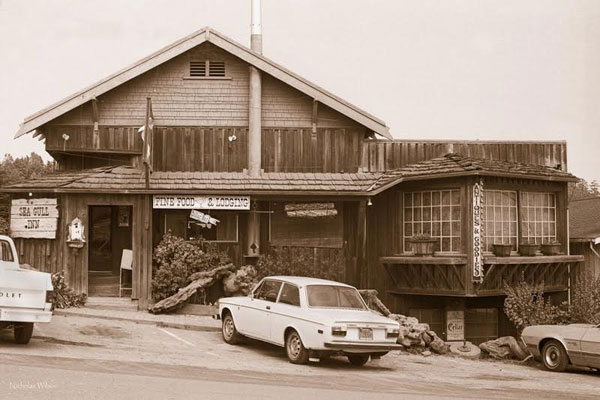
Nicholas Wilson photographer
David: “We had a lady that made the pies, Helen Kiefer. Her daughters worked here, too Helen was a German lady and her husband taught at the high school, foreign languages. She used to walk to work every day, down the hill from Little Lake Rd., where she lived, and make the pies. She was real particular. Martin Hall had brought the recipes from Sacramento, Roseville, wherever he was. There was a really good pie maker there, and he snatched up all the recipes before he came here to the coast. Helen pursued these pie recipes and she was a really good pie-maker; particularly her crusts, which were absolutely excellent. When she left there was a real concern whether we could keep that going, but we did, and we came up with a lot of new recipes and some new ideas and we kept that same recipe for the crust and everything seemed to work out great. Helen is a wonderful person and we hated to see her go. She worked there for a long time.
M: Let’s jump up to the night of the fire; was it a cigarette in the couch?
David: Nobody can be absolutely 100 percent sure. I had some friends that night that were staying with us. We lived in the house behind the restaurant, and these were very good friends, Terry and Judy Johnson. They were staying the night with us at the house next-door, and we had dinner in the restaurant that night, everything seemed normal, we went home.
I woke up the next morning about 5:30, and I looked out he big kitchen window of the residence and saw smoke pouring out of the chimney from the bar, just pouring out of there. But I didn’t see any flames or anything. So I thought that was real peculiar, and I used the connection between the house and restaurant, which is still there, a hallway, and I went into what was originally the living-room of the house. It had become a storage room for the restaurant, and there was a door that opened into the hallway that went into the kitchen of the Sea Gull, so I went into the storage room, and I opened that door. The heat knocked me down it was so hot, a burst of hot air came out at me. I was lucky that I was able to get the door closed again and get up.
When I fell down I guess I made so much noise that I woke up Terry and Judy upstairs. I came back in and for a minute, I couldn’t even talk. I was so distressed and shocked, but I was finally able to yell, “FIRE!”
Terry came downstairs and I told him, “Get out of here, call the fire department immediately and then start getting stuff out of here as fast as you can.”
I got outside and I ran over to Skip Jones’ house, Skip was a block and a half away and he was a fireman. I banged on his door to get him up and over to the fire department. When I ran out, I ran down Ukiah Street, which the house fronts on, and came to Lansing, where the Sea Gull fronts on, and I looked. I could see the flames shooting up out of the Cellar Bar, coming straight out onto Lansing Street, they were clear out into the street and they were curling around and singing the side of the firehouse. Of course, there was a stone wall between the Cellar Bar and the firehouse and that’s the only thing that protected the firehouse. It was a fire-wall and it did its job, otherwise the firehouse would have gone. There was absolutely no doubt about it.
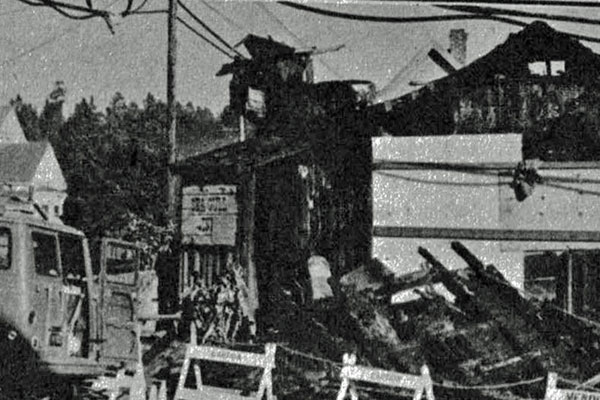
Photographer Linda Luvaas, San Francisco Examiner & Chronicle, California Living Section, February 13, 1977
So I got Skip, and Terry got the phone-call made and the fire people came and eventually got it out.
When we went in and started investigating the downstairs, we had a lot of overstuffed furniture, and that night Tony Miksak was the bartender, and at night the standard routine was, after everybody’s out of the bar, you went around to all the cushions and chairs and just kind of felt for stuff as best you can and then kind of straighten things out and left, you didn’t clean up until the next morning. Well, there were a couple of overstuffed chairs right in front of a wood fireplace in the middle of the room. The wood fireplace was completely closed up tight, so its hard to imagine that a spark or anything came out of it because the doors were shut and there were no openings or holes, so I don’t think it was a spark from the fireplace. But one of the chairs is where the hottest place in the room was. That chair, it was clear that the fire originated there because it burned a hole right down through the cement floor, and that was where it was really hot. Eventually it combusted and it started a flame, and the flames went up the stairway up to the restaurant, they made a little flue, almost like a fireplace downstairs toward the street, but the stuff to the other side of the fireplace, though it got melted to some extent didn’t really get burned up all that much, it went the other way. All we can figure is it was probably a cigarette left in a chair. Somebody had been smoking it, thought it was out and thought they hit an ashtray and missed or something and no indication anyone meant to do anything. It just smoldered and smoldered and smoldered until it finally self-combusted and took off.
M: I was in Albion the morning of the fire, and the first thing I heard was that the Sea Gull burned, and I had been there the night before.
David: It burned down the night of December 12, 1976. It was the birthday of one of my key people whose name was Lorna Chance (it was Lorna Young then). She was a cashier. From the day I bought the Sea Gull to the day I left, she was the cashier there. And it was her birthday!
………………
SOMETHING TO COOK ABOUT
Life in the Sea Gull Kitchen
By Doug Nunn
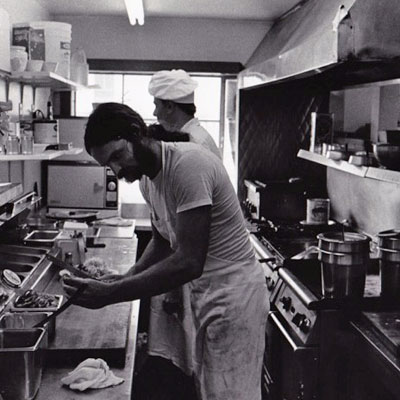
Doug Nunn and David Gottsche cooking in new Sea Gull kitchen
The Sea Gull was the entertainment hot spot in a town with few such diversions. There was creativity galore: murals decked the hallways, grand paintings sparkled down from the walls and music, comedy, and poetry popped off the stage almost every night.
Everybody who worked there seemed to be an artist or intellectual. All the waitpeople were artists. There were painters, dancers, would be Oscar winners and lots of sculptors. Some nights all three waitroids were sculptors.
And all the janitors and many of the dishwashers either had Ph.Ds or had at least published something of significant brilliance. Sheldon Cox and Jim Noyes were masters of pun and trivia behind the water sprayer and who could ever forget the debates between Mitchell Zucker and Gordon Black on everything from Chekhov to cheeseburgers?
In spite of all this, it was the kitchen that was the most fun and ridiculously innovative. We had to improvise and hustle on a daily basis and we figured out some lovely diversions.
There was scientific innovation. It was in the kitchen that Steve Scudder and I worked for weeks to perfect “The Mega Cholesterol Sandwich.” The final product was four fried Farmer John sausages piled high with greasy onions and topped off with four slices of melted American cheese. It was served on a butter grilled English muffin.
And we dallied dangerously with incompatible chemical combinations. Baker Jeanne Sullivan belatedly discovered the power of garlic powder to influence pie-making when a waitress unknowingly spilled the powerful seasoning into her chocolate cream pie filling. Jeanne was on break and it was served before anyone knew … Suffice it to say garlic and chocolate were a molecular combination still new to many of us north of Gilroy.
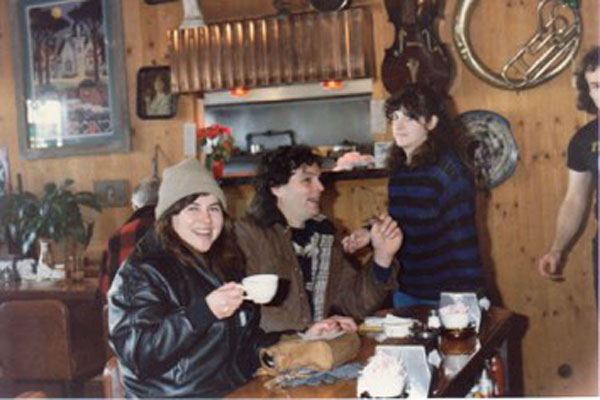
Jeannie Sullivan, Doug Nunn, Tracey Burns, and Sheldon Cox in new Sea Gull coffee shop
Then there was Johnny Robbin’s infamous “Blasto Burger”—a product of competence, agility, and very short work breaks. He demonstrated by pressing a 2-ounce chunk of hamburger on the bottom of a large soup pot. Then he would “address the stove,” hold the pot forward and then step into a trot toward the grill much like a pole vaulter until he hit full stride and slammed the bottom of the soup pot and its unfortunate burger-to-be-passenger straight onto the sizzling grill.
He’d hold for 10 seconds. Then he’d flip the incinerated chunk of “blastomeat” off the bottom of the pan and onto a waiting bun. We had great fun and made “Blastos” for days before the novelty wore off.
The genesis of a comedy act occurred the first weekend I ever worked with Steve Weingarten. We were at “cooking battle station,” desperately trying to whip out a quick soup in the middle of a rush. But, after we got the squash, onions, and mushrooms frying in the garlic, “Weinie” and I started acting like two French cooks. Fully in character he spontaneously emptied the contents of a gallon of House-type Burgundy into the soup. It was an act of performance art, but it took a lot of explaining and a fair amount of chicken bouillon to cover up. Such was born “Tres Burgundy Vegetable Soup” and quite possibly “Les Freres Bearnaise.”
I was not a great cook but I was “King of the Walk-In” in my day. I cleaned it a couple of times a week, knew where almost everything was and battled more than one potential pile of sci-fi vegetative matter. And in emergencies I conjured soup out of what one might generously call leftovers. “Cream of Walk In” was always well received.
But, I butchered breakfast. I humiliated hash browns, murdered eggs, and obliterated omelettes. David Jones was a very patient man.
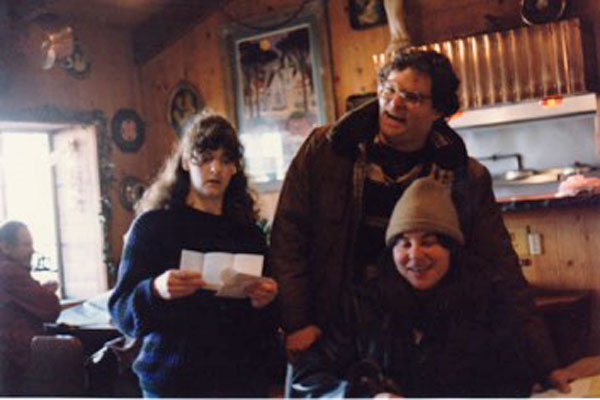
Doug Nunn, Tracy Burns, Jeannie Sullivan studying their comedy lines in the new Sea Gull coffee shop
Thank God I was such a fun guy to work with. Gull cooks were generally a very playful bunch and we goofed around a lot with the customers. But we took things too far now and then. Like the time Scudder told me he bet that if anybody in the coffee shop could take a joke, it would be Bill Kreutzman. He then flying saucered a pancake at excruciatingly slow motion straight into the sleep drummer’s schnozz and then adroitly pulled back leaving my smiling face alone in the kitchen window. Needless to say, it wasn’t my day and Bill used me for a percussion vocal.
There was no safety for beast or vegetable in our kitchen. I saw grown men dance with chicken carcasses and I saw vegetables put in very compromising positions. One night Noyes, Robbin, Scudder, Weinie and I hung a hapless potato in effigy from the kitchen ceiling. Somehow that spud had pissed us off. You had to be there, it was an Animal vs. Plant thing. Still it was a well decorated tuber and thus died in dignity.
We decorated lots of food to impress customers. I would often make faces on various entrees that went out. Typical was an “enchinada” with alfafa sprout hair, a cherry tomato nose, a half slice of orange for a mouth and shredded beets for a moustache. Some would argue with the beets. Still, I once sent one out to kiss up to Bonnie Raitt and she sent the leftovers back arranged in a funny face. I knew right away that Bonnie must be a Sea Gull kitchen kind of person. She has that right balance of creativity and goofiness. And she might even be able to cook.
……………….
M: Everybody around town knows that the Sea Gull was built right up again, almost immediately. What was the actual arrangement with that? Everybody says it was all volunteer labor. Did you pay some people?
David: It was not all volunteer labor. There was a lot of volunteer help. First, we had to go through the demolition part and that was primarily volunteer, it was primarily employees, Dick Barham, Paul Townsend, Steve Scudder, Steve Weingarten, those guys are all still around. They were all employees and I just called them up and they said they’d come in for a couple of days and take care of it. So we just tore everything apart and got it into big piles of junk, and the Don Pollard came over with his crane and we got a big dumpster and he agreed to just pull everything up out of there and dump it in the dumpster. That was pretty much all volunteer stuff and then we had a lot of last minute stuff, pull the floor up and do the yucky stuff, that was pretty much volunteer. At some point when it became clear that it was going to be more than just that, we got down to the real construction part of the demolition. We utilized the same foundation and we utilized the same fire-wall to some extent. We had to tear it down a little bit and rebuild it and make it somewhat different, but we utilized a lot of that stuff, so at some point, once we got all the junk out that had burned up, we had to be more careful, more professional about what we were doing. So, I hired David Clayton.
David was going to build a house for Cathy and I. In fact, he was going to start the week after the fire happened. So I called him up on the Sunday, and I told him, instead of a house we were going to need work on a restaurant. I hired him and his crew. They came in and we quickly put some plans together for a new restaurant and he took over the demolition part when it came to the point that it needed to be done properly. At that point we were able to get our permits fairly quickly because it was pre-existing use.
David was never a contractor, he was a builder. I was owner-contractor and he was the builder. But in essence, David was responsible, because I was not a builder, I had never built a building before. He put the plans together, we got those through the review board and through the county and got them all stamped and approved, everything was done exactly as it was supposed to be done. In fact, I kept the plans and kept all the stamps for whatever reason. David and his crew built the Sea Gull, and he had a great crew of people then. Some guys are still here, some are not. Some of the ones that aren’t were: David’s foreman, Michael Nielsen, Gus Acosta, and Phil Brock. Chris Browne is still here.
These were paid carpenters working for David. It was essentially the normal relationship. Everybody agreed to bend the rules a little bit and work as cheap as they could. The volunteers came in and did the cleanup; sweeping, getting the garbage out. A couple of people who were actually carpenters who wanted to come in, they could work. A lot of them were professional carpenters, and David would say, “I’m going to frame this wall today, we’re going to do this,” and they could go out, put two guys on that and get it done, so we did get some volunteer help that way. It was a combination of volunteer and paid help. We had a very low budget, but we did have a budget, we borrowed the money to build it.
M: What did it actually cost to rebuild?
David: I think the out of pocket money was about a hundred thousand dollars, something like that. The rest of it was either trades, or donations, or the idea that people would be paid later.
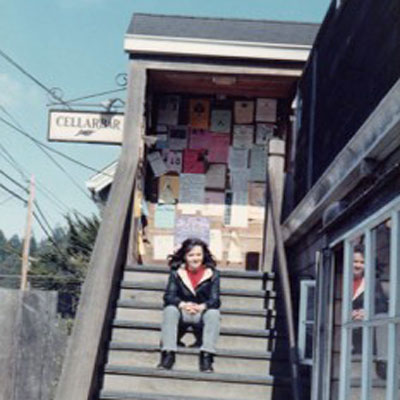
Waitress Carolyn Lundquist sitting on outside stairs to new Cellar Bar
For instance, upstairs in the bar, the big fire-beam that Stan Kelley made, he brought it in and did it. He wanted to do it and I wanted him to do it, and I paid him for it over the years until he was paid, but he didn’t give me a bill that day and say, “Pay me now.” But it was paid for. Later on, all the big paintings that James Maxwell did. Max wanted to do the Pied Piper painting for free, with the stipulation that he would have control over that if the place ever sold, which we worked out at the time.
M: Does Max own the paintings now?
David: No, the paintings are owned by Jim Marquardt. Except for the Pied Piper painting, the rest of all the paintings were commissioned by me and paid for. The Pied Piper painting was separate, but Jim Maxwell and I worked out a deal on those paintings that as far as I know, Jim Marquardt owns the artwork. He bought everything when he bought the place.
There was a combination of volunteers and professional. But mostly it was professional in terms of the actual construction. And there were people that didn’t know what they were doing that did things that drove David Clayton absolutely crazy. And he and I talked about this all the time, and he would go nuts, and then he’d have to turn around and redo it all, but when you’re dealing with volunteers, that’s what’s going to happen.
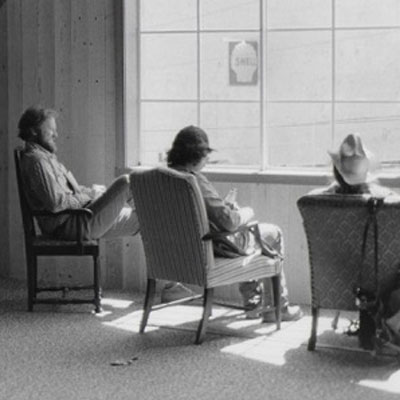
David Clayton, Gus Acosta, Don Bell in partially finished new bar
M: Was any of that stuff, that was done at that time, have anything to do with the later condemning of the construction, does it go back that far?
David: I don’t think so, Mike, but yeah, it goes back that far, because, for example, the first thing that came up to be a problem for the Sea Gull was the upstairs bar had an outside deck, and I always wanted to enclose it, but I couldn’t enclose it legally, because the law is, between the firehouse and the Sea Gull there had to be a fire-wall with a certain number of hours of protection, and if you had an open deck like we had, the restrictions were reduced, so we could have the open deck and we could have the tables right up against the windows there and there was no problem, but if we enclosed it, we had to put a fire-wall on that side and it would have blocked the view. You couldn’t see the ocean; that was the only place from upstairs you could see the ocean from, so I never did it. Later, when Jim came in, he had somebody enclose the deck, and I think he had some problems as a result of that afterwards.
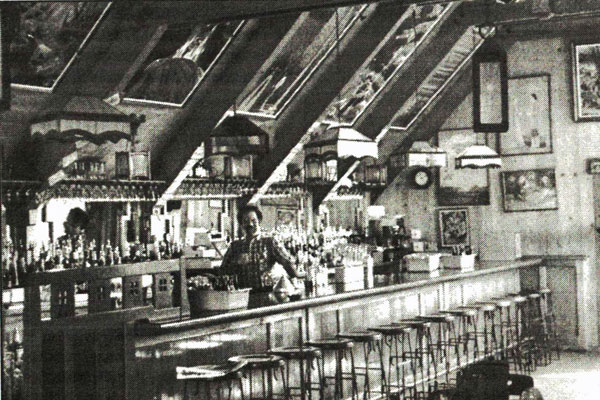
Bartender Brian Krasno in the new Cellar Bar
M: Apparently he never got any permits for it.
David: You’ll have to talk to him about that.
M: I was in the bar one day and the building inspector came in and said, “Well, when did they do this?”
David: That outside deck enclosure was not my doing. That was the beginning of the problems between Marquardt and Sayers, at least the visible beginning of the problems between them. At that point, Sayers brought in the building inspector to look at the whole place, and determined that there were several things that needed to be taken care of. When I got involved in the process, everything that we did when we rebuilt the place was done with legal permits according to our plans. Now, some of the rules have changed over the years, but that doesn’t mean they were done incorrectly. They were done correctly, I have the stamped plans, there were some questions concerning engineering of that big window up in the bar, that big triangular window, but I had the plans with the stamped engineer reports on them and so on and so forth, and the county stamped them as approved, and they were done, according to those plans. We used the old tile floor in he kitchen; after the fire it was still there, it was still intact and it was still okay. We built right on that, had it re-sealed, put some extra tiles in various places, and we used the same fire-wall between the firehouse and the Sea Gull. We had to take off the top couple of layers and a few sides and then replace parts, but it was all inspected and approved as being acceptable. So I don’t think that rebuild led to any of those later problems. I think that what led to the later problems is that the building is now almost twenty years old. A restaurant withstands a lot of water, you wash things every day and things get wet, and a lot of traffic and a lot of use and grease and smoke and all that sort of thing and things wear out and you have to replace them over a period of time.
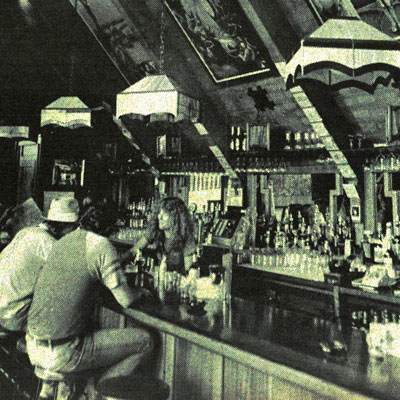
Bartender Laurie Hill in the new Cellar Bar
M: I’ve been under the Sea Gull a few times and I fixed a few things underneath there. Its not the most pleasant place down there.
David: No, it isn’t.
M: Were you making a good income from it?
David: Yes, I was making a good income from it.
M: Because some people are saying that David sold it because he wasn’t making any money.
David: No, that’s ridiculous. In reality, selling the Sea Gull was the stupidest thing I ever did, because it would have run itself. It did run itself. I had Marlene, I had Steve Scudder. Carl Hayward and I ran the bar, and I had wonderful employees, and the place ran itself.
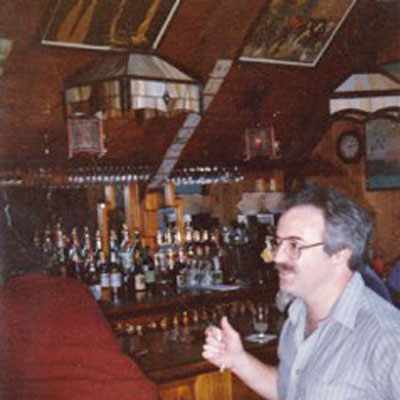
David Jones in the new Cellar Bar
************
Jim Marquardt purchased the Sea Gull from David Jones. I talked with Jim while sitting in the Sea Gull Cellar Bar in early October. Portions of the building are in various stages of repair construction, and so nothing is where it should be. All the carpets are removed, which gives the place a sad, neglected feel. A very different feeling from the last time I was in there.
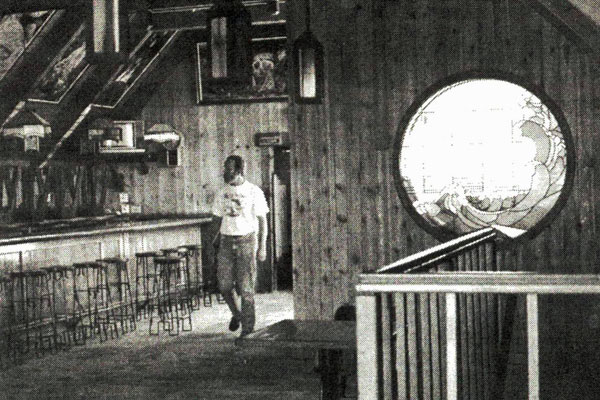
Jim Marquardt inspecting remodel of Cellar Bar
M: When did you actually buy the Sea Gull?
Jim: We closed escrow August 15, 1985.
M: When you bought the place were you aware of what the Sea Gull meant to the community? The way people looked at it?
Jim: Yes and no. A little bit, but not how the community thought it was theirs. They really wanted to run things.
M: Was that surprising?
Jim: That they wanted to run it and we couldn’t, yeah, and they didn’t want anything to change. That was surprising and the fact that they acted like they owned it. Mostly people up in the bar.
M: How long before you bought it had you lived up here?
Jim: We’d been living here about 4 years. I had a cabinet shop in the house we had bought. We were just feeling our way along trying to figure out exactly what we wanted to do. Rochelle had always wanted to have a little restaurant of some sort. We tried to buy the Brings Building for a long time. They just wanted too much, they wouldn’t budge, the deal just never worked out, and then this came along, and it was a better investment we thought.
M: When you bought the Sea Gull, did you have a vision of how you wanted the Sea Gull to be?
Jim: Not for awhile. My attitude has always been to ride with it and see how it feels. It’s not much different than buying a house. It’s not like you can remodel it before you even live in it. You have to get a feel for it.
We had some ideas, in general, but not specifically. Six months down the line, a year down the line, we’d realize, for example, the coffee shop should be changed. It was neat, but dinner and tables were much more important. Even breakfast turned out to be more comfortable, for most people. It still gave it the coffee shop atmosphere in the morning, but it gave us the flexibility of tables at night. That did really well with the dinner crowd. It had some problems just with logistics … for instance the hole in the wall to the kitchen, it was smoky, dirty. It was neat to say hi to the cooks, but it didn’t make it so special to eat dinner.
M: Did you have a longterm plan the, once you figured out what you wanted it to be?
Jim: Well, it built up over time, it was not money. It was based on quality, dealing with size and seating. It wasn’t the type of restaurant for designer food and chefs.
M: Definitely not. Especially the Sea Gull, it was known for its inexpensive good meals.
Jim: We had always tried, food-wise, to be a buck or two less than everybody else, but with the same quality and more quantity than most places. Without getting into arts and crafts types of foods, this place didn’t warrant a big name chef. Richard Hubik was a trained chef, but he enjoyed this place. But then again, sooner or later he wanted to move to someplace more “gourmet.” But for the most part, Judy Griswold was a chuck wagon kind of cook, and after her we basically had our own kitchen managers rather than “chefs.” Rochelle was behind what went out of trhat kitchen. We didn’t need a big name chef.
M: Everybody kind of looks at the restaurant, but then there’s the Cellar Bar. There was a time after you bought it where people had the feeling “Oh, he doesn’t want any locals in there.” Did you feel that at the time?
Jim: We felt it, but we felt misunderstood because what we wanted was the locals in here. I wanted more of the homey atmosphere. The first reaction almost before we took over, and then immediately thereafter, was that the bar and the restaurant were two different entities, as if they didn’t have any relationship at all. The crowds were completely different, like they didn’t talk to each other. It could have been two separate businesses. And we wanted a much more homey, local, relaxed atmosphere that went with the restaurant. Businessmen lunches, I wanted those guys up here instead of hanging around somewhere else. I wanted them sitting around having lunch and a few drinks. I wanted everything here. It truly worked out that way. The realtors, the attorneys, everybody ended up here. I wanted the sports-type crowd in here, because I felt it was a good crowd and it wasn’t a 2 o’clock in the morning crowd.
The bar was always a winner at night, and I know one bad reaction that we got was closing a little early. Most of the people who came in after 12 or twelve-thirty were not to easy to ask to leave at 2 am. The bartenders didn’t need it. They got a little edgy with the really late crowd. The ones that sat here until the third last call, the bartender’s could do without ‘em. We didn’t have 250 pound bartenders in here to put out the crowd.
The idea was to make it work better with the restaurant, make it work better for food service. There was a lot of space up there that wasn’t being utilized, two thirds of the time and we needed more dining tables during the summer. It worked better that way. We found out real quick how many people we needed in here to make a go of it. It didn’t do anybody any good if the place was losing money.
M: One complaint I heard was, “I went down to the Sea Gull to watch that 10 a.m. football game, and Jim wouldn’t let me in to see it.” I said in reply, “Well, they aren’t open at 10 am.” It wasn’t a 49ers game, it was a game that was real important for the 49ers that somebody wanted to watch.
Jim: 49er games at 10 am, we were always open. Others, it was hard.
We tried it, there would be a few people sitting there for three hours. We just weren’t able to do it.
M: I talked to David about the way you rearranged things, and he said that you made it run much more efficiently in actually making more money. And you had a higher profit margin, and you were still running everything. I had no idea, I thought maybe low profits had to do with why you were selling it. Why did you decide to sell?
Jim: Couple three reasons. You get tired of the long hours and the responsibility and the never ending problems and never getting away. Especially the hours and the days. We were only closed a few days a year, and there was constant maintenance. The business was just at that size where we couldn’t completely leave it alone, couldn’t just turn it over to a well-paid manager and expect it to run rthe same and not have to worry. We looked. There were a couple of people in the area that had the potential, but they didn’t pan out, they weren’t interested, so we knew we were stuck. So if we wanted to go out somebody had to be there who was really in charge. Rochelle and I kind of had a deal where she was going to hopefully phase out after five years or so, I wasn’t too sure I wanted to do it alone after that.
We did have managers, and pretty good ones, but it still looked like we were there day and night for the long haul. A general manager could handle it for a number of days while we were gone, but not for weeks. It’s tough when you can never look forward to time away.
The opportunity to sell just came along, I guess. We had kind of decided, off the record, to put it up for sale and see what happened. The Beaujolais people almost bought it, but it didn’t quite work out price and financing wise. I had a certain number in mind, which turned out to be pretty close to what it was worth, and Barry Cusick came along and came up with a low-down, lease-option idea. We looked at it tax-wise and income-wise, it made sense. So we gave it a shot. The idea was ok, but the buyer’s weren’t.
M: Why do you think George and Rita Sayers couldn’t make a go of a thriving business?
Jim: They didn’t like it here. They tried to change everything, and I told them, “Sit tight for six months, it’s not like you’re walking into something that needs fixing or isn’t making money.” They immediately wanted to change the menu and the clientele. I remember telling him, “There are things that definitely need improving, but don’t try and change things in the summer. Let it ride through the winter, see how you feel come spring.”
I’m sure some subtle changes, maybe some advertising would have helped them. I didn’t do much in those days, people came here anyway.
There were a lot of little things, but things just grew stale … not immediately.
It’s not like they made massive changes, but they immediately wanted to get rid of any reference to us. We were very unwelcome on the premises. They didn’t like it here, and they didn’t like the people, and they made no bones about it. They didn’t want our help or advice or anybody else’s for that matter. They hated the bar. They wanted it out of here, they wanted Jim’s friends out of here. George said to me: “We got rid of those garbage friends of yours, we’ve cleaned up the bar, and we’re cleaning up the garbage crowd you had in here.”
See how it changed. Everyone thought I was running David’s little crowd out of here, and the next time around, George was running my old crowd out of here.
M: Maybe it was obvious with them tht they did not want any locals in there. It was like, “We don’t want you, we don’t need you.”
Jim: They didn’t like Mendocino, they didn’t like anything. Rita’s vast cooking experience turned out to be a couple of cocktail parties. His vast food experience turned out to be buying food for some distributor or something but that was it. He was in the Navy and he was the epitome of the Peter Principle.
M: Oh, really?
Jim: Yeah.
M: At that time, were you tempted to just keep it going?
Jim: We would have, if they hadn’t cleaned it out. Every bit of supplies.
M: They took the supplies with them?
Jim: They put all the supplies in their garage to sell the day before they offered it to us, but I didn’t want that kind of garbage. Instead of good stuff, they bought the cheapest stuff they could find. I didn’t want it. Same thing with the alcohol, everything. And they took the liquor license. Which kind of killed coming right back in.
M: So they owned the liquor license?
Jim: Sure, we had sold it. We almost had a deal with them a few months later, to forget the whole thing and take it back over. Instead of coming to us, and saying “We’re not happy, we don’t like this, we’re not making as much as we thought we would, or we want to make.” Instead, they hired Bob Peterson to try to make a mess out of it, and see how they could get out of the whole thing. We probably could have worked something out, but they were sue-happy.
M: So since that time, have you basically been involved in the lawsuit?
Jim: No, that was over a year and a half ago, the lawsuit. It took two years to get to court. The lawsuit kind of hund over it, but never stopped anybody from buying it. Peter Wells lease-optioned it in September, 1993, but then he backed out and sued also.
M: Are there offers now?
Jim: There are a couple of offers in he works right now, but nothing very definite. They’re trying to work out a whole lot of contingencies.
M: Do they want to run it, or just lease it out?
Jim: Both.
M: Is that a group, or can you say?
Jim: I can’t really say.
M: I was wondering if it was like you said, just pure investment or other people involved who really just want to open it up again? What do you think it will be like? Like The Jarvis-Nichols building partnership, something like that?
Jim: That’s one possibility.
M: Is it in escrow?
Jim: No. Not at this time.
M: Do you have any idea what may happen, just from your personal outlook with your experience of what happened before? What you see might happen, what would you like to see happen?
Jim: I’d like to see somebody bring it up and running pretty much like it was, I’d like to see that. It’s going to be on a little smaller scale, I’m sure.
M: Looking back on it, everybody felt like it was like their living room, especially up in the bar. It was like, “Well, what do we do?” Well, we go and meet in our living room at the Sea Gull.
There was a rumor about the Mexican food restaurant …
Jim: It wasn’t a rumor, a guy was going to go in to the old bakery space, but he backed out at the last minute. He had a business in Costa Rica, he decided to go with that. His idea was to get this up and running and he had a friend and partner who was going to run it for him. Hopefully a small Mexican takeout could have worked with the restaurant next door.
M: That was one nice thing about the restaurant everything was made right there.
Jim: That’s what made it go, too. The whole thing worked so well together, the bar, the bakery, and the restaurant. They sent customers to each other.
M: Anything that you think people don’t know about that you’d like them to know about the Sea Gull? That people misunderstood or that they don’t understand now? Everybody’s asking, “Why isn’t the Sea Gull open? Its been closed for so long, it seems so ridiculous.”
Jim: The lawsuit’s put a cloud over it, and all the factors within the lawsuit, a small rumor in this town gets blown way out of proportion in a big hurry. The Sayer’s attitude and failure also put a cloud over it and ruined the value and reputation of the business. There were some minor building department problems left over from David Jones and David Clayton that caused some problems and also got blown way out of proportion. Then the Peter Wells purchase fell through and he’s still trying to sue his attorney. It hasn’t been pretty.
…………..
In August of 1990 Jim sold the Sea Gull business to George and Rita Sayers. George was a retired navy Admiral who had never owned and operated a restaurant/bar before. They hired a manager (Ira Rosenberg), and also a bartender named John Delzanero. John was the last bartender to work at the Cellar Bar. He was working when the Building Dept. came in and told everybody to leave because the building was being red tagged for permit violations. John told everyone to leave. The Sayers reopened a week later but then closed shortly thereafter. They left a lawsuit with Jim Marquardt as they left town, in February of 1992.
In September of 1993, Peter Wells bought the Sea Gull from Jim Marqardt. His motivation for buying the property was to “… bring back that community place that the Sea gull used to be. In the ‘70s and ‘80s it was the most incredible place, for happy hour it was absolutely packed, but people didn’t go there to drink, they came to meet.
“I’m hoping to put in a nightclub area, concentrating on solo performances, comedy, monologues and songs … and, of course people can eat upstairs.
“If we put to much emphasis on serving tourists we will loose what we came up here for, and consequently the tourists won’t find what they came up here for.”
I recently talked with Peter Wells about his involvement in the Sea Gull, and although he could not discuss details with me because of still pending legal litigation, he did offer this statement:
“Little did I know I was stepping into a legal quagmire. It turned out that Ji Marquardt did not have clean title to what he sold me. I tried for over a year to work this deal out.
“It has been a very unpleasant experience and a loss for the community too.”
For several reasons, that I can’t go into now (maybe in a special Part 3), the deal between Peter Wells and Jim Marquardt soured. Peter’s plans never got a chance to materialize and The Sea Gull still sits, hollowed out like some Halloween jack o’lantern, waiting in the dark for someone to light its interior so it can again shine in the Mendocino night.
The building that witnessed such happenings as the now infamous Sea Gull Gong Show, The Dating Game, Sunday afternoon Napkin Art, numerous birthday bashes and countless impromptu parties that defined the town and its residents, deserves the attention equal to the joy we have derived from it in the past.
………………….
The Sea Gull Restaurant and Cellar Bar did not reopen. The building is now divided into commercial shops with a residence upstairs. (Think In The Morning)
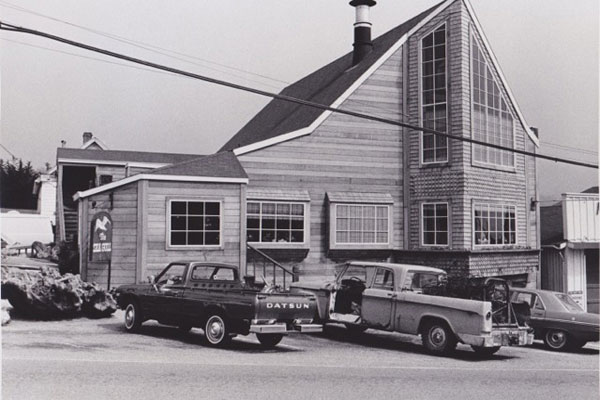
The New Sea Gull building constructed by David Clayton and crew, 1977, photographer Nicholas Wilson

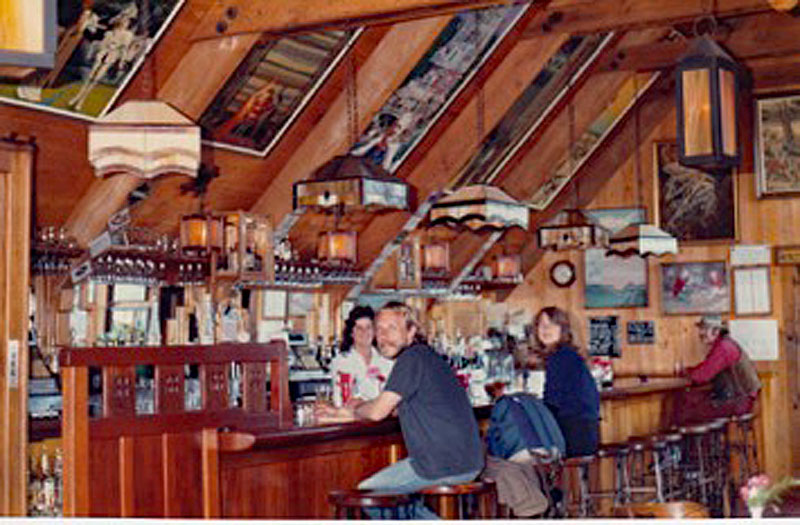
Fun To Read Pops
I was working there during the remodel, John Fredricks and I did a lot of work on it. Marquardt didn’t really give two shits about a lot of what was being done. John and I came in one night and carefully removed JC’s stairway mural and secured a place to store it. I don’t know what became of it after I moved away. John probably does. It was Marquardt’s wife that had the business sense, he certainly didn’t.